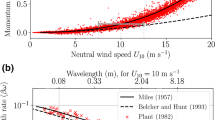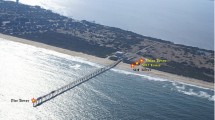Abstract
Turbulent air-sea interactions coupled with the surface wave dynamics remain a challenging problem. The needs to include this kind of interaction into the coupled environmental, weather and climate models motivate the development of a simplified approximation of the complex and strongly nonlinear interaction processes. This study proposes a quasi-linear model of wind-wave coupling. It formulates the approach and derives the model equations. The model is verified through a set of laboratory (direct measurements of an airflow by the particle image velocimetry (PIV) technique) and numerical (a direct numerical simulation (DNS) technique) experiments. The experiments support the central model assumption that the flow velocity field averaged over an ensemble of turbulent fluctuations is smooth and does not demonstrate flow separation from the crests of the waves. The proposed quasi-linear model correctly recovers the measured characteristics of the turbulent boundary layer over the waved water surface.







Similar content being viewed by others
References
Adrian RJ (1991) Particle imaging techniques for experimental fluid mechanics. Annu Rev Fluid Mech 23:261–304
Banner ML, Melville WK (1976) On the separation of airflow over water waves. J Fluid Mech 77:825–842
Batchelor G K (1967) An introduction in fluid dynamics. Cambridge University Press. 615 pp
Black PG, D’Asaro EA, Drennan WM, French JR, Niiler PP, Sanford TB, Terrill EJ, Walsh EJ, Zhang JA (2007) Air–sea exchange in hurricanes: synthesis of observations from the coupled boundary layer air–sea transfer. Exp Bull Am Meteorol Soc 88(3):357–374
Caudal G (1993) Self-consistency between wind stress, wave spectrum, and wind-induced wave growth for fully rough air-sea interface. J Geophys Res 98(C12):22743–22752
Donelan MA, Haus BK, Reul N, Plant WJ, Stiassnie M, Graber HC, Brown OB, Saltzman ES (2004) On the limiting aerodynamic roughness of the ocean in very strong winds. Geophys Res Lett 31, L18306
Donelan MA, Babanin AV, Young IR, Banner ML, McCormick C (2005) Wave follower field measurements of the wind input spectral function. Part I: measurements and calibrations. J Atmos Oceanic Tech 22(7):799–813
Druzhinin O A, Troitskaya Y I, Zilitinkevich S S (2012) Direct numerical simulation of a turbulent wind over a wavy water surface. J Geophys Res 117(C00J05). doi:10.1029/2011JC007789
Emanuel KA (1995) Sensitivity of tropical cyclones to surface exchange coefficients and a revised steady-state model incorporating eye dynamics. J Atmos Sci 52(22):3969–3976
Esau I (2003) Coriolis effect on coherent structures in planetary boundary layers. J Turbul 017
Esau I (2004) Simulation of Ekman boundary layers by large eddy model with dynamic mixed subfilter closure. Environ Fluid Mech 4(3):273-303
Esau I, Davy R, Outten S, Tyuryakov S, Zilitinkevich S (2013) Structuring of turbulence and its impact on basic features of Ekman boundary layers. Nonlinear Process Geophys 20:589–604
Fairall CW, Bradley EF, Hare JE, Grachev AA, Edson JB (2003) Bulk parameterization of air–sea fluxes: updates and verification for the COARE algorithm. J Climate 16(4):571–591
Garratt JR (1977) Review of drag coefficients over oceans and continents. Mon Weather Rev 105:915–929
Holthuijsen L H, Powell M D, Pietrzak J D (2012) Wind and waves in extreme hurricanes. J Geophys Res 117(C09003). doi:10.1029/2012JC007983
Hsu CT, Hsu EY (1983) On the structure of turbulent flow over a progressive water wave: theory and experiment in a transformed wave-following coordinate system. Part 2. J Fluid Мech 131:123–153
Hsu CT, Hsu EY, Street RL (1981) On the structure of turbulent flow over a progressive water wave: theory and experiment in a transformed, wave-following co-ordinate system. J Fluid Mech 105:87–117
Hwang P A (2005) Wave number spectrum and mean square slope of intermediate-scale ocean surface waves. J Geophys Res 110(C10029). doi:10.1029/2005JC003002
Hwang PA, Wang DW (2004) An empirical investigation of source term balance of small scale surface waves. Geophys Res Lett 31, L15301. doi:10.1029/2004GL020080
Hwang PA, Burrage DM, Wang DW, Wesson JC (2013) Ocean surface roughness spectrum in high wind condition for microwave backscatter and emission computations. J Atmos Oceanic Tech 30:2168–2188
Janssen PA (1991) Quasi-linear theory of wind wave generation applied to wave forecasting. J Phys Oceanogr 21:1631–1642
Janssen P A (2004) Interactions of ocean waves and wind. Cambrige Univ. Press, 300 pp
Jenkins AD (1992) Quasi-linear eddy-viscosity model for the flux of energy and momentum to wind waves using conservation law equations in a curvilinear coordinate system. J Phys Oceanogr 22:843–858
Kawai S (1981) Visualisation of air flow separation over wind wave crest under moderate wind. Bound-Layer Meteorol 21:93–104
Kawai S (1982) Structure of air flow separation over wind wave crest. Bound-Layer Meteorol 23:503–521
Kawamura H, Toba Y (1988) Ordered motion in turbulent boundary layer over wind waves. J Fluid Mech 197:105–138
Makin VK, Kudryavtsev VN, Mastenbroek C (1995) Drag of the sea surface. Bound-Layer Meteorol 73:159–182
Miles JW (1957) On the generation of surface waves by shear flow. Part I. J Fluid Mech 3:185–204
Moin P, Kim J (1985) The structure of the vorticity field in the turbulent channel flow. Part 1. Analysis of instantaneous fields and statistical correlations. J Fluid Mech 155:441–464
Powell MD, Vickery PJ, Reinhold TA (2003) Reduced drag coefficient for high wind speeds in tropical cyclones. Nature 422:279–283
Reul N, Branger H, Giovanangeli J-P (1999) Air flow separation over unsteady breaking waves. Phys Fluids 11(7):1959–1961
Reul N, Branger H, Giovanangeli J-P (2008) Air flow structure over short-gravity breaking water waves. Bound-Layer Meteorol 126:477–505
Reutov VP, Troitskaya YI (1995) On nonlinear effects due to water wave interaction with turbulent wind. Izv Russ Acad Sci Atmos Ocean Phys 31:825–834
Smolyakov AV (1973) Spectrum of the quadruple radiation of the plane turbulent boundary layer. Acoust Phys 19(3):420–425
Sullivan PP, McWilliams JC, Moeng C-H (2000) Simulation of turbulent flow over idealized water waves. J Fluid Mech 404:47–85
Troitskaya YI, Rybushkina GV (2008) Quasi-linear model of interaction of surface waves with strong and hurricane winds. Izv Atmos Ocean Phys 44(4):621–645
Troitskaya YI, Sergeev D, Ermakova O, Balandina G (2011) Statistical parameters of the air turbulent boundary layer over steep water waves measured by the PIV technique. J Phys Oceanogr 41:1421–1454
Troitskaya YI, Ezhova EV, Sergeev DA, Kandaurov AA, Baidakov GA, Vdovin MA, Zilitinkevich SS (2013) Momentum and buoyancy exchange in a turbulent air boundary layer over a wavy water surface. Part 2. Wind wave spectra. Nonlinear Process Geophys 20:841–856
Veron F, Saxena G, Misra SK (2007) Measurements of the viscous tangential stress in the airflow above wind waves. Geophys Res Lett 34, L19603. doi:10.1029/2007GL031242
Vickery VJ, Wadhera D, Powell MD, Chen Y (2009) A hurricane boundary layer and wind field model for use in engineering applications. J Appl Meteorol Climatol 48:381–405
Acknowledgments
This work is supported by grant of the government of the Russian Federation (contract 11.G34.31.0048), Federal Targeted Program “Scientific and Pedagogical Staff for Innovative Russia” for 2009–2013 and by RFBR (13-05-00865, 13-05-97068, 13-05-12093) and by the bilateral Norwegian-Russian project CLIMARC. Alexander Kandaurov and Olga Ermakova acknowledge partial support from Russian Science Foundation (Agreement No. 14-17-00667).
Author information
Authors and Affiliations
Corresponding author
Additional information
Responsible Editor: Huijie Xue
This article is part of the Topical Collection on the 5th International Workshop on Modelling the Ocean (IWMO) in Bergen, Norway 17-20 June 2013
Rights and permissions
About this article
Cite this article
Troitskaya, Y., Sergeev, D.A., Druzhinin, O. et al. Atmospheric boundary layer over steep surface waves. Ocean Dynamics 64, 1153–1161 (2014). https://doi.org/10.1007/s10236-014-0743-4
Received:
Accepted:
Published:
Issue Date:
DOI: https://doi.org/10.1007/s10236-014-0743-4




